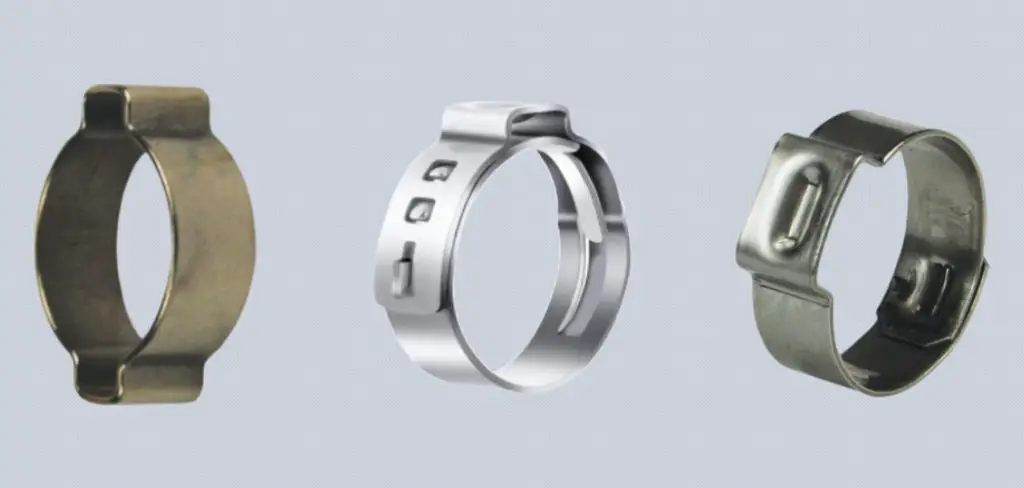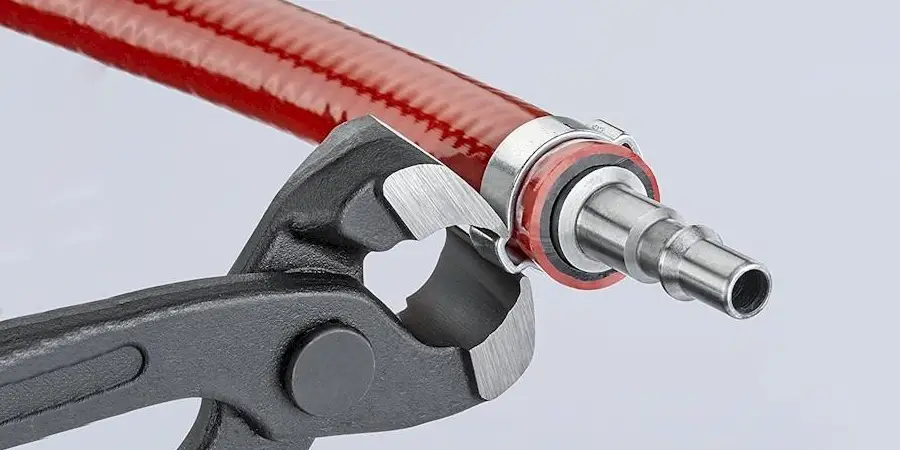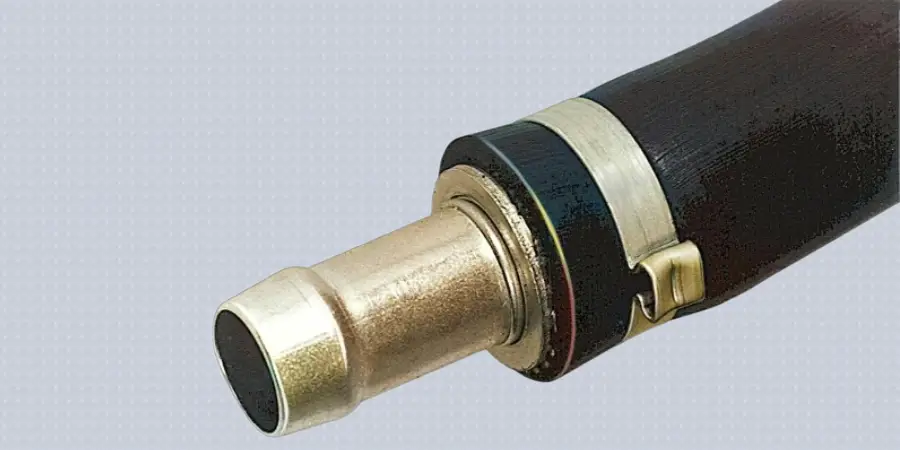Ear clamps, also known as Oetiker clamps or crimp clamps, are popular single-use fasteners for securing hoses and tubing. Unlike reusable clamps, ear clamps are permanently crimped closed and cannot be loosened or reused.

This guide explains the correct tools, materials, and techniques to safely crimp ear clamps, with detailed safety advice and troubleshooting tips.
What Are Ear Clamps?
Ear clamps are metal bands with one or two small “ears” that are crimped tightly to secure hoses. They provide a neat, low-profile, and reliable seal for hoses in automotive, plumbing, HVAC, and industrial systems. The crimp permanently deforms the clamp, creating a firm grip that resists leaks and slippage.
Important: Ear clamps are single-use. Once crimped, they cannot be opened or reused.
Types of Ear Clamps
- One-Ear Clamps:
These have a single crimping ear and are typically used for light to medium duty tasks. They are ideal where moderate pressure resistance is required, such as smaller fuel or vacuum lines. - Two-Ear Clamps:
These feature two ears positioned opposite each other, which allows for a more even and stronger grip on the hose. Two-ear clamps are common in applications requiring higher pressure resistance or increased vibration tolerance. - Variations:
Some clamps come with slightly different ear sizes or band widths to suit specific hose diameters or application environments. Additionally, there are clamps made of different materials to match environmental and chemical compatibility requirements.
Safety Information
Personal Protective Equipment (PPE)
Always wear safety glasses to protect your eyes from flying debris or sharp edges during crimping. Use work gloves to protect your hands from sharp metal edges and to improve grip on tools.
Pressure Release Procedures
Before working on any pressurized system—whether hydraulic, pneumatic, or fluid—fully relieve system pressure. Pressurized hoses can burst suddenly, causing injury or damage.
Temperature Considerations
Never work on hot hoses or systems without allowing them to cool down first. Heat can cause burns and affect the clamp’s ability to seal properly. Also, some clamp materials have temperature limits, so verify suitability for your system temperature.
Chemical Compatibility
Check the clamp material against the fluids and gases handled by the hose. For example, stainless steel resists corrosion from most fluids, but galvanized steel or aluminum clamps may corrode faster in aggressive environments.
Single-Use Warning
Ear clamps are permanent fasteners. Do not attempt to remove and reuse clamps once crimped. Using damaged or reused clamps can lead to leaks and system failures.
Material and Technical Specifications
Materials
- Stainless Steel: Most common for ear clamps due to excellent corrosion resistance and durability. Grades like 301 and 304 stainless steel are standard.
- Galvanized Steel: Lower cost but less corrosion resistant. Suitable for dry, non-corrosive environments.
- Aluminum: Lightweight and corrosion resistant but less strong than steel.
Temperature Ranges
- Stainless steel ear clamps typically perform well between -40°C and 150°C. Some specific grades or designs may vary.
- Plastic or polymer clamps vary greatly. Some types handle only up to 60°C, while high-performance plastics tolerate up to 100°C or more. Always check manufacturer specifications.
Pressure Ratings
Pressure capability depends on:
- Clamp size and ear design
- Hose material and thickness
- Installation quality and crimp completeness
Manufacturers usually specify maximum working pressures for their clamps. It is crucial to consult product datasheets rather than rely on general estimates.
Crimping Force and Torque
Unlike screw clamps, ear clamps do not use torque for tightening. Instead, they require a correct crimping force applied with a proper tool to deform the ear and reduce the clamp diameter. The required force varies by clamp size and material and must be applied evenly to avoid damage.

Tools and Equipment
Ear Clamp Pliers (Crimping Tools)
Use tools specifically designed for ear clamps. These pliers or crimpers match the ear shape and size to apply uniform pressure. Examples include:
- Manual ear clamp pliers for small-scale or light-duty work
- Pneumatic or hydraulic crimping tools for industrial or high-volume applications
Alternative Tools
In tight or awkward spaces, specialized angled or compact crimpers are available.
Tool Maintenance
Keep tools clean, lubricated, and inspect regularly for wear or damage to ensure consistent crimps.
Avoid General Pliers
Standard pliers, needle-nose pliers, or pincers are not suitable and can cause improper crimps, clamp damage, or hose injury.
How to Properly Crimp Ear Clamps
- Select the Right Clamp: Measure the hose or tube outer diameter accurately. Refer to clamp packaging or datasheets to pick the correct size. A properly sized clamp should fit snugly before crimping.
- Prepare the Hose and Clamp: Wipe away dirt, oil, grease, or moisture from the hose surface where the clamp will sit. Slide the clamp onto the hose, positioning it near the connection point or fitting.
- Position the Clamp: Ensure the clamp band sits evenly and the ear is accessible for crimping. The band should be parallel to the hose end or fitting to avoid leaks.
- Crimp the Ear: Use the correct ear clamp pliers to squeeze the clamp ear until fully closed and flattened. The crimp should be uniform with no gaps or cracks. A properly crimped ear usually looks fully collapsed or “pinched.”
- Inspect the Crimp: Confirm the clamp is tight and secure. Check for even band placement and absence of slack. If the clamp moves or slips, replace with a new, properly sized clamp.
- Do Not Reuse: If removal is necessary, cut the clamp off and discard it. Always install a new clamp.
Troubleshooting
- Clamp Slipping or Leaking: Common causes include incomplete crimp, wrong clamp size, or damaged clamp. Replace with a new clamp and ensure full ear closure.
- Damaged or Deformed Clamp: Do not use clamps with cracked ears, rust, or visible damage. They cannot hold pressure reliably.
- Incorrect Crimping: Uneven or partial crimps reduce sealing ability. Use the correct tool and apply even pressure.
- Hose Damage from Overcrimping: Applying excessive force can cut or deform the hose. Use the right clamp size and crimp carefully.
Application-Specific Guidance
- Automotive: Ideal for fuel, coolant, and vacuum lines. Use stainless steel clamps to resist heat and fluids. Confirm clamp specifications for engine bay temperatures and pressures.
- Plumbing: Plastic or metal ear clamps secure flexible water supply hoses or drain tubes. Use corrosion-resistant clamps in moist environments.
- HVAC: Secure duct hoses and condensate lines using two-ear clamps for vibration resistance.
- Industrial: Heavy-duty clamps and hydraulic crimpers provide reliable seals in harsh, high-vibration, or corrosive environments.
Installation Environment Considerations
- Tight Spaces: Use compact or angled crimping tools designed for restricted access areas.
- Wet or Corrosive Conditions: Choose stainless steel or specially coated clamps to prevent corrosion.
- High Vibration: Double clamping or clamps with reinforced ears improve reliability.
Maintenance and Longevity
- Inspection Schedule: Inspect clamps every 3 to 6 months in typical conditions. Inspect more often in safety-critical or harsh environments.
- Signs for Replacement: Look for corrosion, cracked ears, loosening, or hose damage.
- Storage: Keep unused clamps in a dry, clean environment to avoid premature corrosion.
Quality and Standards
- Industry Standards: Look for clamps certified to ISO 16232, SAE J1508, or equivalent.
- Quality Features: Smooth edges, consistent ear shape, clear size markings, and corrosion-resistant coatings indicate quality.
- Cost vs Quality: Choose reputable brands. Low-cost clamps may save money initially but can fail prematurely.
Advanced Techniques
- Double Clamping: Use two clamps spaced apart on hoses in high-pressure or high-vibration applications for added security.
- Series Clamping: Long hose sections benefit from multiple clamps spaced evenly to distribute pressure.
- Temporary vs Permanent: Ear clamps are permanent fasteners. Use temporary clips or bands if removability is needed.
- Field Repairs: Emergency repair kits with temporary clamps can be used but replace with proper ear clamps promptly.

Conclusion
Ear clamps are reliable, low-profile fasteners that provide permanent hose sealing. Correct clamp selection, cleaning, and proper crimping with the right tool are essential. Always wear PPE, never reuse clamps, and regularly inspect for damage. Follow this guide to secure hoses safely and professionally every time.
Read More – How to Use a Lock Washer With a Flat Washer
